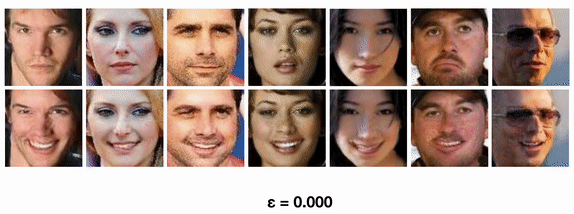Official PyTorch implementation of Disrupting Deepfakes. This repository contains code for adversarial attacks (disruptions) for (conditional) image translation networks. The StarGAN, GANimation, pix2pixHD and CycleGAN networks are included - and the attacks can be adapted to any image translation network. We include adaptations of FGSM, I-FGSM and PGD attacks. We also include our class transferable attacks, adversarial training for image translation networks and spread-spectrum evasion of blur defenses.
Disrupting Deepfakes: Adversarial Attacks Against Conditional Image Translation Networks and Facial Manipulation Systems
Nataniel Ruiz, Sarah Adel Bargal, Stan Sclaroff
Boston University
https://arxiv.org/abs/2003.01279Abstract: Face modification systems using deep learning have become increasingly powerful and accessible. Given images of a person's face, such systems can generate new images of that same person under different expressions and poses. Some systems can also modify targeted attributes such as hair color or age. This type of manipulated images and video have been coined Deepfakes. In order to prevent a malicious user from generating modified images of a person without their consent we tackle the new problem of generating adversarial attacks against such image translation systems, which disrupt the resulting output image. We call this problem disrupting deepfakes. Most image translation architectures are generative models conditioned on an attribute (e.g. put a smile on this person's face). We are first to propose and successfully apply (1) class transferable adversarial attacks that generalize to different classes, which means that the attacker does not need to have knowledge about the conditioning class, and (2) adversarial training for generative adversarial networks (GANs) as a first step towards robust image translation networks. Finally, in gray-box scenarios, blurring can mount a successful defense against disruption. We present a spread-spectrum adversarial attack, which evades blur defenses.
StarGAN Dataset
cd stargan
bash download.sh celeba
StarGAN Models
bash download.sh pretrained-celeba-256x256
GANimation Dataset
cd ganimation
mkdir -p data/celeba/images_aligned/new_small
We use a third-party public pre-processed (cropped faces) version of the CelebA dataset that can be found here. Please download datasets/celebA/imgs.tar from this Google Drive folder, extract imgs.tar and move these images into ganimation/celeba/images_aligned/new_small
GANimation Models
The pretrained models can be downloaded here. They should be located at ganimation/models
CycleGAN Dataset and Models
Follow instruction in the CycleGAN official repository for downloading their models and data.
pix2pixHD Dataset and Models
Follow instruction in the pix2pixHD official repository for downloading their models and data.
Here are bash commands for testing our vanilla attacks on each different architecture.
# StarGAN Attack Test
cd stargan
python main.py --mode test --dataset CelebA --image_size 256 --c_dim 5 --selected_attrs Black_Hair Blond_Hair Brown_Hair Male Young --model_save_dir='stargan_celeba_256/models' --result_dir='stargan_celeba_256/results_test' --test_iters 200000 --batch_size 1
# GANimation Attack Test
cd ganimation
python main.py --mode animation
# pix2pixHD Attack Test
cd pix2pixHD
python test.py --name label2city_1024p --netG local --ngf 32 --resize_or_crop none
# CycleGAN Attack Test
python test.py --dataroot datasets/horse2zebra/testA --name horse2zebra_pretrained --model test --no_dropout
If you want to change the attack method being used, look into the attack.py scripts in each architecture folder and change the number of iterations, attack magnitude and step size. You can also re-run the class transferring and blur evasion experiments on StarGAN by commenting/uncommenting lines 54-61 in stargan/main.py or modifying the stargan/solver.py script to change the attack type.
In order to change attack types for GANimation you can modify lines 386-470 by commenting out the vanilla attack and uncommenting the attack you want to run.
In order to run G+D adversarial training on StarGAN run:
# StarGAN Adversarial Training
python main.py --mode train --dataset CelebA --image_size 256 --c_dim 5 --sample_dir stargan_both/samples --log_dir stargan_both/logs --model_save_dir stargan_both/models --result_dir stargan_both/results --selected_attrs Black_Hair Blond_Hair Brown_Hair Male Young
If you wish to run vanilla training or generator adversarial training, comment/uncomment the appropriate lines (l.44-49) in stargan/main.py
We use code from StarGAN, GANimation, pix2pixHD, CycleGAN and advertorch. These are all great repositories and we encourage you to check them out and cite them in your work.
If you find this work useful for your research, please cite our paper:
@article{ruiz2020disrupting,
title={Disrupting Deepfakes: Adversarial Attacks Against Conditional Image Translation Networks and Facial Manipulation Systems},
author={Nataniel Ruiz and Sarah Adel Bargal and Stan Sclaroff},
year={2020},
eprint={2003.01279},
archivePrefix={arXiv},
primaryClass={cs.CV}
}

